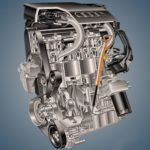The 1.6-liter Volkswagen AEE engine was assembled at the concern’s factory from 1995 to 2000 and installed on such popular company models as Golf 3, Vento, Caddy 2 and Polo 3. This unit is known to many by the first generation of Skoda Octavia.
The EA111-1.6 series includes: ABU, AEE, AUS, AZD, BCB, BTS, CFNA, CFNB.
Specifications
| Production years | 1995-2000 |
| Displacement, cc | 1598 |
| Fuel system | injector |
| Power output, hp | 75 |
| Torque output, Nm | 135 |
| Cylinder block | cast iron R4 |
| Block head | aluminum 8v |
| Cylinder bore, mm | 76.5 |
| Piston stroke, mm | 86.9 |
| Compression ratio | 9.8 |
| Features | SOHC |
| Hydraulic lifters | yes |
| Timing drive | belt |
| Phase regulator | no |
| Turbocharging | no |
| Recommended engine oil | 5W-30 |
| Engine oil capacity, liter | 4.0 |
| Fuel type | petrol |
| Euro standards | EURO 3 |
| Fuel consumption, L/100 km (for VW Golf 3 1996) — city — highway — combined |
10.5 6.0 7.3 |
| Engine lifespan, km | ~330 000 |
The engine was installed on:
- Volkswagen Caddy 2 (9K) in 1996 – 2000;
- Volkswagen Golf 3 (1H) in 1995 – 1997;
- Volkswagen Polo 3 (6N) in 1995 – 1999;
- Volkswagen Vento 1 (1H) in 1995 – 1998;
- Seat Cordoba 1 (6K) in 1997 – 1998;
- Seat Ibiza 2 (6K) in 1997 – 1999;
- Skoda Felicia 1 (6U) in 1995 – 2001;
- Skoda Octavia 1 (1U) in 1996 – 2000.
Disadvantages of the VW AEE engine
- Most of the problems for owners are caused by an unreliable ignition system.
- In addition to distributor failures, etc., the wiring often simply rots here.
- Poorly located engine control unit often fails.
- The reason for floating engine speeds is usually a dirty throttle or idle speed controller.
- Regularly here you have to change the thermostat and antifreeze temperature sensor.






